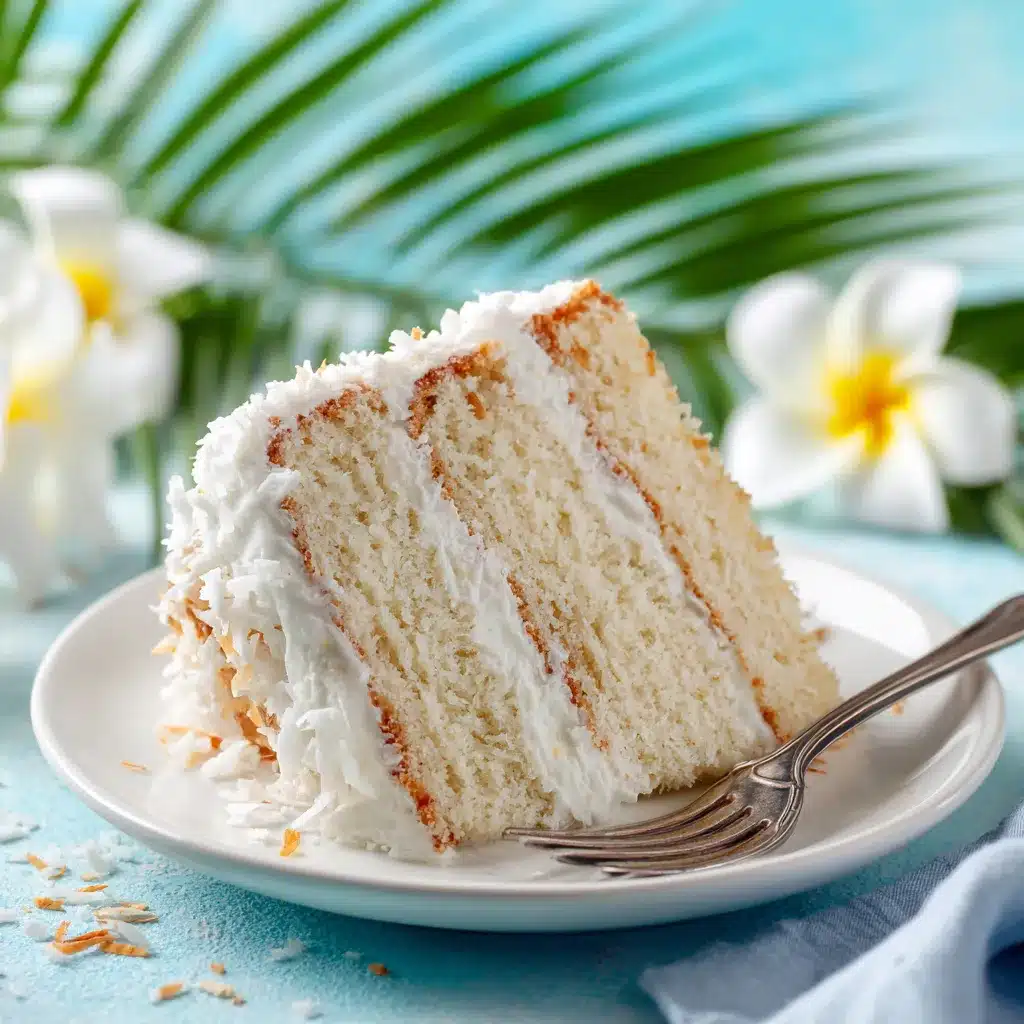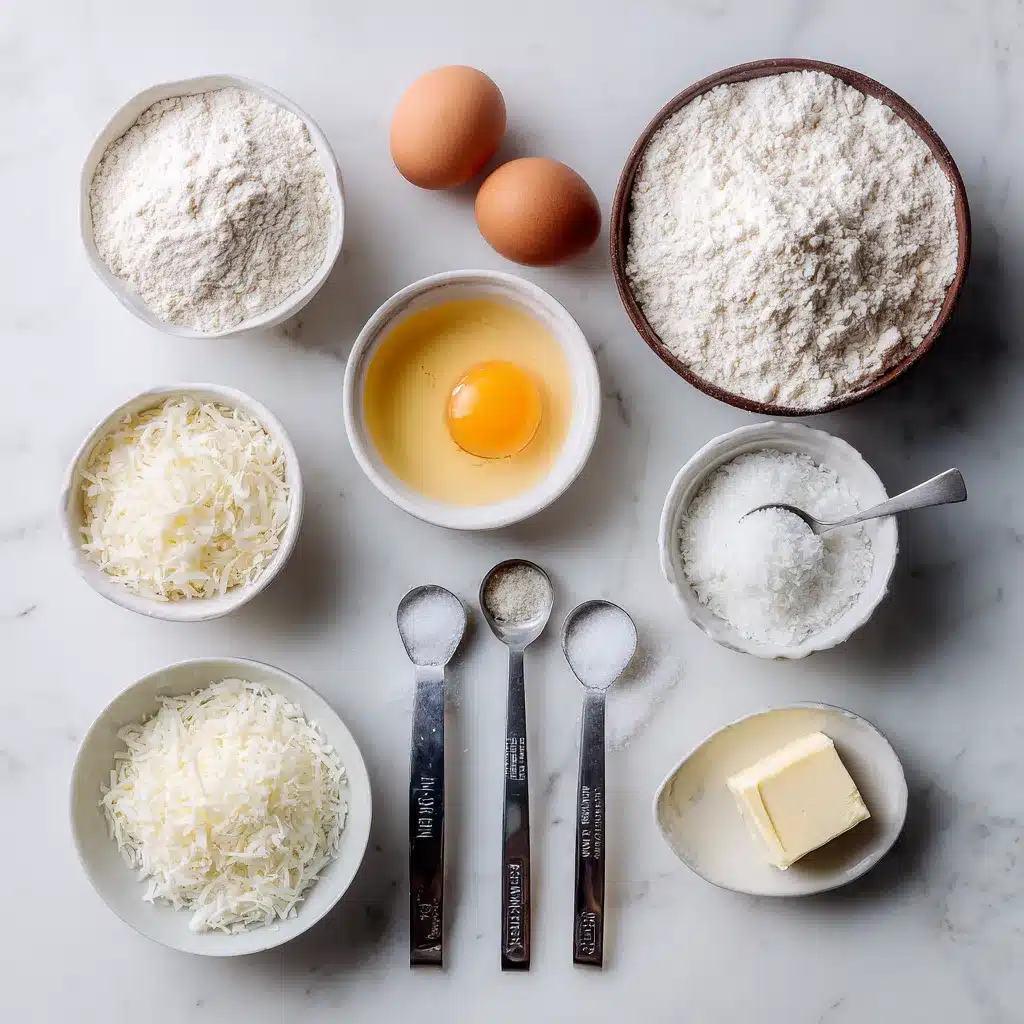
Some desserts just feel like sunshine, and this coconut cake recipe is one of them. It’s soft, moist, and carries that sweet tropical aroma that reminds you of beachside memories and family gatherings. Whether you’re a longtime coconut lover or trying something new for a celebration, this cake always delivers joy in every slice. In this guide, we’ll share our favorite coconut cake recipe, variations you’ll love, and tips to make it turn out beautifully every time.
Table of Contents
ToggleThe Story & Intro – Why This Coconut Cake Stands Out
The Coconut Cake That Became a Family Legend
Every year, my aunt would bring her famous coconut cake to our summer picnic. Light, tender, and packed with coconut flavor, it disappeared faster than any other dessert. I remember watching her layer it carefully, always brushing each cake round with coconut milk before stacking. The frosting? A soft whipped topping covered with sweetened shredded coconut — like a fluffy tropical cloud.
When I started baking on my own, her recipe was the first I asked for. She didn’t measure much, relying on instinct and experience, but what made it special was how it brought people together. That’s what this coconut cake recipe is all about — tradition, warmth, and the kind of treat people always come back for seconds.
This version keeps everything we love: richness from coconut milk, texture from shredded coconut, and a tender crumb that never feels heavy. It’s the kind of cake you bring to birthdays, showers, and spring brunches — and it never lasts long.
We’ve shared similarly unforgettable cakes like our almond nut cake and mandarin orange cake, but this coconut cake recipe truly stands in a league of its own.
Why Coconut Cake Recipes Are Trending Again
There’s something nostalgic and comforting about coconut cake. It feels homemade, yet elegant. With coconut milk, oil, or butter as a base, these cakes offer moisture and richness that hold up well in any season.
More home bakers are searching for coconut cake recipes not just for taste, but because they’re simple to personalize — like adding pineapple or a citrus twist. And thanks to the rise in tropical-inspired desserts, coconut is finally getting the spotlight it deserves.
If you love cakes that taste as beautiful as they look, this coconut cake recipe might just become your next go-to.
Ingredients & Variations for the Best Coconut Cake Recipe

The Must-Have Ingredients for a Moist Coconut Cake Recipe
If you want your coconut cake recipe to be tender and flavorful, start with the right ingredients. The real secret to achieving that soft, melt-in-your-mouth texture is using both coconut milk and shredded coconut. Coconut milk adds rich moisture, while shredded coconut brings that extra chew and texture in every bite.
You’ll also need standard cake basics: all-purpose flour, eggs, sugar, baking powder, and either butter or a light oil. If you want a richer flavor, use unsalted butter softened to room temperature. For a fluffier cake, a neutral oil like canola keeps it light and moist.
Pure vanilla extract rounds out the flavor, but don’t skip the coconut extract — it gives that bold coconut taste without being overpowering. You can also fold a bit of sour cream or yogurt into the batter for added richness.
For inspiration, the base of our pudding cake recipe uses similar moisture-locking techniques that work beautifully with coconut as well.
Tasty Twists: Variations to Try in Your Coconut Cake Recipe
One of the best parts of any coconut cake recipe is how easily it adapts. Want something fruity? Try a pineapple coconut cake by adding crushed pineapple to the batter — the tropical combo is unbeatable.
You can also play with citrus by folding in lime or lemon zest for a refreshing kick. It’s a great idea for summer get-togethers or baby showers. Our lemon bundt cake shows how citrus brightens every bite.
For a richer dessert, swirl chocolate into the batter and top with toasted coconut flakes. Or bake the batter into cupcakes and top with coconut whipped cream for individual servings that still feel festive.
Each variation keeps the heart of the coconut cake recipe intact, while giving you a fresh spin to match the occasion or season. It’s a dessert that’s endlessly adaptable — and always crowd-pleasing.
Print
Coconut Cake Recipe – Moist, Tropical, and Easy to Make
5 Stars 4 Stars 3 Stars 2 Stars 1 Star
No reviews
This coconut cake recipe is soft, moist, and full of tropical flavor. Perfect for birthdays, brunches, and everyday celebrations.
- Total Time: 50 minutes
- Yield: 12 servings 1x
Ingredients
2½ cups all-purpose flour
2 tsp baking powder
½ tsp salt
1 cup unsalted butter, softened
1¾ cups sugar
4 eggs
1 cup canned coconut milk (full fat)
1 tsp coconut extract
1 tsp vanilla extract
1 cup sweetened shredded coconut
Instructions
1. Preheat oven to 350°F. Grease and line two 8-inch round cake pans.
2. In a bowl, whisk flour, baking powder, and salt.
3. Cream butter and sugar until light and fluffy. Add eggs one at a time.
4. Mix in vanilla and coconut extract, then add coconut milk.
5. Gradually combine wet and dry ingredients. Fold in shredded coconut.
6. Divide batter into pans and bake for 25–30 minutes.
7. Cool completely. Frost with coconut buttercream and decorate.
Notes
Store covered at room temperature for 2 days, or refrigerate up to 5.
Freeze slices individually for up to 2 months.
- Author: Tiramisu Cake
- Prep Time: 20 minutes
- Cook Time: 30 minutes
- Category: Cakes
- Method: Baking
- Cuisine: American
- Diet: Vegetarian
Nutrition
- Serving Size: 1 slice
- Calories: 345
- Sugar: 28g
- Sodium: 220mg
- Fat: 18g
- Saturated Fat: 13g
- Unsaturated Fat: 4g
- Trans Fat: 0g
- Carbohydrates: 40g
- Fiber: 2g
- Protein: 4g
- Cholesterol: 65mg
Coconut Cake Recipe Steps You Can Trust
Baking a Coconut Cake Recipe Without the Stress
Making a perfect coconut cake recipe doesn’t require fancy techniques. It’s all about combining real ingredients with simple steps. Start by preheating your oven to 350°F and preparing two 8-inch cake pans with parchment paper and a light layer of butter.
This coconut cake recipe begins by whisking flour, baking powder, and salt in one bowl. In another, beat softened butter and sugar until creamy. Add eggs one at a time, then pour in coconut milk and coconut extract. Mix the dry and wet ingredients until just combined — that’s key to keeping the coconut cake recipe soft. Gently fold in shredded coconut.
Divide the batter between the pans and bake for 25–30 minutes. When a toothpick comes out clean, your coconut cake recipe is ready. Let the cakes cool completely before frosting.
Frosting and Decorating This Coconut Cake Recipe
To finish this coconut cake recipe, you’ll need a light, flavorful frosting. A classic coconut buttercream is perfect — blend butter, powdered sugar, coconut milk, and a drop of coconut extract until smooth. It spreads easily and tastes amazing.
Frost between the cake layers, then cover the top and sides. Press sweetened shredded coconut onto the frosting. You can toast it for a golden color or leave it white for a snowy effect. The coconut cake recipe doesn’t need much to shine — it’s already rich in flavor and texture.
With every bite, this coconut cake recipe delivers that soft, moist crumb people love. It’s ideal for birthdays, showers, or casual get-togethers. If you’re ready for more, try our million-dollar pound cake for another celebration-ready option.
Serving, Storing, and Fully Enjoying This Coconut Cake Recipe
The Best Ways to Serve Your Coconut Cake
Once your coconut cake is baked, cooled, and beautifully frosted, it’s time to think about how to serve it in a way that makes it unforgettable. For clean, sharp slices, dip a serrated knife in hot water and wipe it dry between cuts. It’s a small step that keeps the layers looking neat — especially important when your cake is on display.
This coconut cake recipe pairs well with fresh toppings like pineapple chunks, sliced mango, or a handful of blueberries. A drizzle of light glaze or a dusting of toasted coconut can elevate the look without adding complexity. For brunch or afternoon tea, serve alongside our almond nut cake or lemon bundt cake for a table that truly shines.
If you’re hosting a larger gathering, cut the cake into squares or mini portions and plate them individually. Add edible flowers or mint leaves for a fresh finishing touch.

Smart Tips to Store Your Coconut Cake the Right Way
To keep the texture and flavor just right, it’s important to store your coconut cake properly. Once it’s cut, cover any exposed cake with plastic wrap or wax paper. Then, place the entire cake in an airtight container and keep it on the counter for up to two days — no refrigeration needed unless your frosting is dairy-based.
If your home is warm or you’re storing it longer, refrigerate the cake. Before serving, let it sit out for about 30 minutes to return to its soft, tender texture. This coconut cake recipe also freezes well. Wrap slices tightly in parchment and place in freezer bags. When you’re ready to enjoy, thaw them in the fridge overnight or leave at room temperature for an hour.
What makes this coconut cake recipe so practical is how well it holds up — even days later, the flavor is just as rich, and the crumb stays moist. Whether you’re enjoying a fresh slice or one that’s been frozen for later, each bite feels like a tropical treat.
Frequently Asked Questions About Coconut Cake Recipe
What makes a coconut cake recipe moist?
A moist coconut cake recipe typically uses coconut milk or coconut cream in the batter, which adds richness and soft texture. Some recipes also include sour cream or yogurt to increase moisture without making the cake heavy. Proper mixing and avoiding overbaking are also key.
Can I use canned coconut milk in a coconut cake recipe?
Yes, canned coconut milk is a great choice. Be sure to shake the can well before using. For best results, use full-fat coconut milk to give your coconut cake recipe that signature soft crumb and tropical flavor.
What is the best frosting for a coconut cake recipe?
Coconut buttercream is a classic choice, made with butter, powdered sugar, coconut extract, and coconut milk. Cream cheese frosting is also popular and adds a nice tang that balances sweetness. Light whipped toppings work well for warm-weather events.
How do I toast coconut for topping a cake?
Spread sweetened or unsweetened shredded coconut on a baking sheet. Bake at 325°F for 5–7 minutes, stirring once, until lightly golden. Let it cool before using it to decorate your coconut cake recipe. Toasted coconut adds both crunch and nutty flavor.
Conclusion
A truly great coconut cake recipe is more than just a dessert — it’s a taste of something sunny, soft, and unforgettable. With the right ingredients, a little care in preparation, and creative finishing touches, you can make a coconut cake that steals the spotlight at any gathering. Whether you’re baking it from scratch or customizing it with fruit, citrus, or toasty toppings, this recipe is one you’ll turn to again and again.
For more delightful bakes that follow the same heartwarming approach, don’t miss our pudding cake recipe or the always-impressive strawberry pound cake. And remember: the best recipes are the ones that feel like home.




